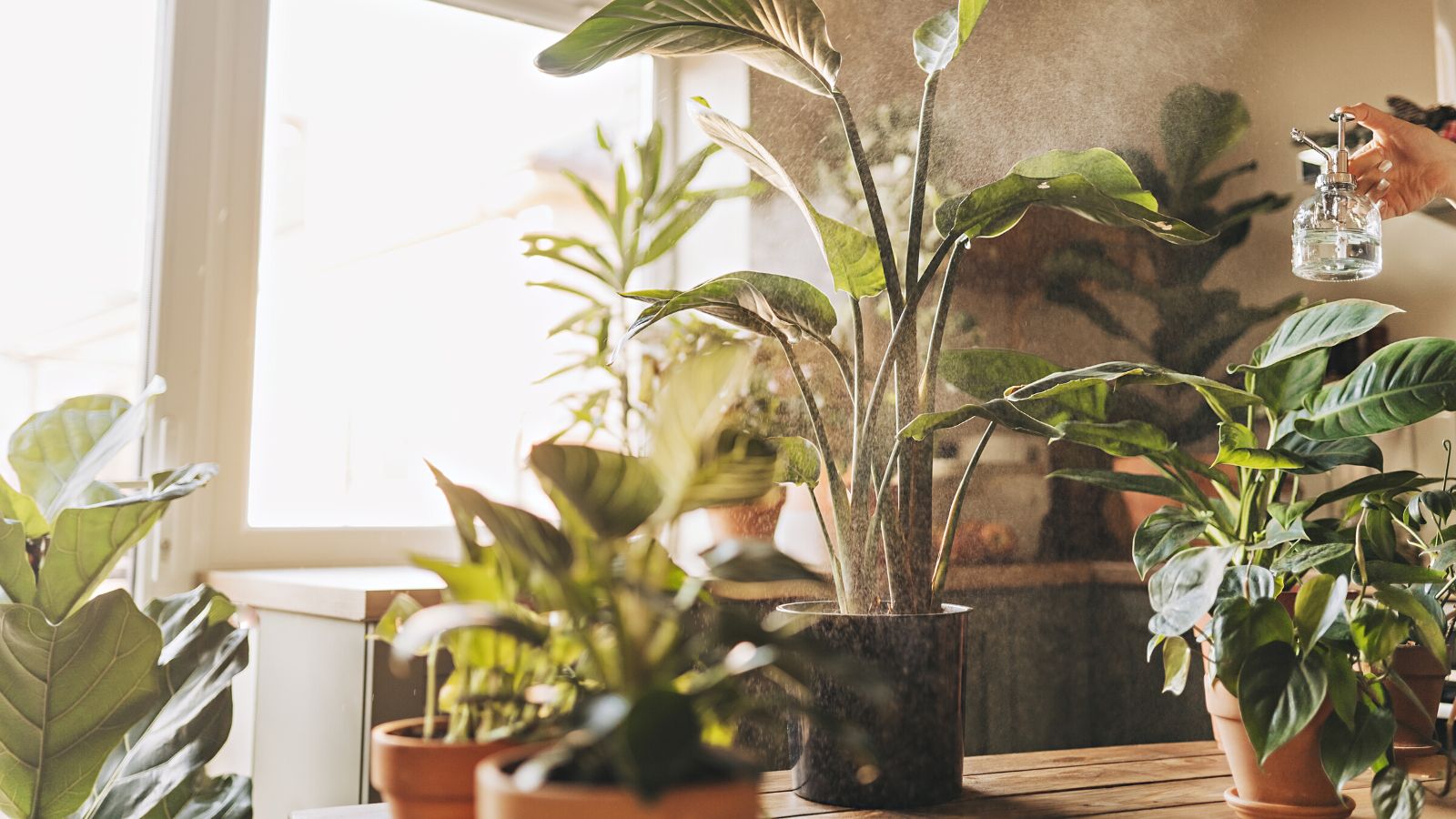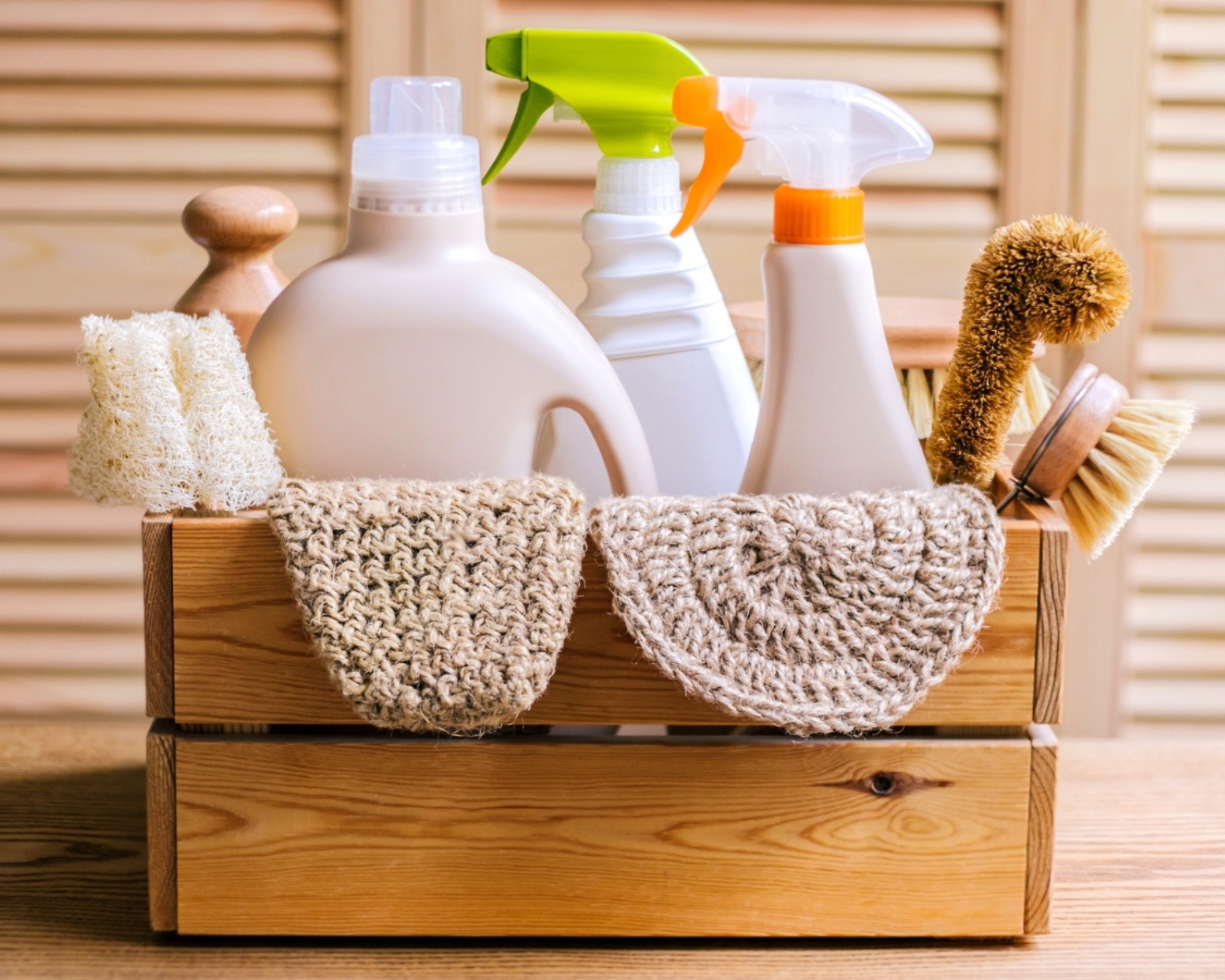What makes a healthy 'home microbiome' – and how disrupting yours can cause illness, mold and even bad body odor
You might have heard of a gut microbiome, but the delicate balance of fauna and flora applies to the inside of your home, too


Taking care of your gut with a healthy diet bumps up immunity and delivers a host of other benefits for your body and mind. But did you know your house also has a microbiome – a mix of bacteria and other microbes – and disrupting it can lead to asthma, allergies, and bad body odor for residents, as well as mold and damp in your home.
A beneficial home microbiome is packed with good bacteria to stop bad germs, fungus and mold taking hold and growing out of control. Here, experts from the cleaning and scientific community share what a good home microbiome is, what can disrupt it (including harsh chemicals, pets and building work) the disastrous effects that can take hold and how to keep yours in check.
Learning about a healthy microbiome for your home can ward off illness, and also prevent you a habit that increases the risk of mold in your home.
What is a home microbiome?
Dr Jerome Burke, Jr, a medical toxicologist (that's a physician-scientist) and medical contributor for Drugwatch, explains, 'A microbiome is the community of microorganisms including bacteria, fungi and viruses that inhabit an ecosystem. In this instance, we are referring to a home where humans, and sometimes pets live, and happen to share the space with massive amounts of microorganisms.'
According to one study, the dust in our homes alone contains an average of 9,000 different species of microbes. Dr Burke explains, 'Researchers from the University of Colorado at Boulder analyzed the dust found in 1,200 households across the United States and discovered the types of bacteria and fungi varied depending on where the home was located, who lived there and whether pets were present.'
What makes one home's microbiome different to another?

A bright and airy space
Both indoor humidity and temperature influence the diversity of bacterial communities inside your home. This is why it's important to have good ventilation and airflow at home, reducing the risk of mold growing.
Likewise, the size of your space and how often you clean it will impact the balance. 'As could the ventilation rate, the number of occupants in the home, or the specific materials used on a given building surface,' adds Dr Burke.
Different dust types can also impact the make up of the microbes.
'For example, mattress dust is dominated by species originating from the user of the mattress, whereas floor dust reflects outdoor sources,' says Dr Burke.
This can of course be diversified by pets in the home, too, making it important to keep a clean home when you have pets. Content editor Chiana Dickson found dusting a chore until she gave the Damp Duster a go.

Chiana Dickson, our Solved content editor found the Damp Duster to be transformative, satisfying and easy to use.
'Farming homes contain higher microbial load than urban homes and according to a recent study,' Dr Burke explains, 'temperate climate zones show higher dust microbial diversity than tropical zones.'
Another study found many species of fungus that trigger allergies are more abundant in dust found in drier regions, which bring to the fore the importance of regular dusting at home, particularly when there is a household member with allergies, or you live in a drier region of the US.
Learn more about the ways your home might be making you ill in our dedicated guide.
Interestingly, the types of bacteria found in interior dust samples for studies in this field largely depended on the ratio of male to female residents and the presence of pets such as dogs and cats. Dr Burke explains, 'Distinctly different bacteria were found in homes that had women and homes that were male-only. There are some kinds of bacteria that are more common on women's bodies than on men's, and we can see the impact of that on the bacteria found in house dust. Also, bringing a dog or cat into your home really has a significant effect on the bacteria you find in your home.'
Learn how to keep a house clean with cats, and housekeeping tips for dog owners.
'The fungi found inside homes were similar to those found outside, suggesting that these microbes probably were brought in from the environment and had little to do with household inhabitants,' Dr Burke adds.
What makes a healthy home microbiome?

A modern and clean bedroom
There are many factors that could influence microbial diversity within homes, but the relative importance of each of these is yet to be extensively researched and determined. Still, Dr Burke says a study has shown scientists could predict the function of different spaces in the home, just by analyzing the microbial samples, meaning from room to room, microbiomes will vary.
'These predictions became more accurate with increased urbanization,' he says. 'While microbial richness did not change with more modern home architecture, bacterial composition was markedly different.'
In particular, human mouth and gut bacteria from the Streptococcaceae and Lactobacillaceae families can be found in most home microbiomes, leaving the household open to illness. As well as regular cleans, deep cleaning the dirtiest areas of your home such as bathrooms are a must to keep these bacteria in check.
'The boost in these human-associated microbes could increase transmission of potential pathogens and decrease exposure to potentially beneficial environmental microbes,' he says.
In layman's terms, where humans live, common germs exist too, meaning a regular cleaning routine you can stick to is important, though, as we discuss later in this article, too much cleaning and use of harsh chemicals can be counterproductive to your home's microbiome, and your health.
How cleaning impacts your home's microbiome

A clean and well-maintained kitchen
Dr Burke says, 'Environmental health researchers study how indoor microbiome affects human health and well-being and studies suggest that indoor concentrations of microbiomes are increasing, driven by factors such as the types of chemicals in home products, inadequate ventilation, hotter temperatures, and higher humidity.
He explains this is a global issue, with short and long-term exposure causing a range of health issues, including respiratory diseases, heart disease, and cognitive deficits.
'Certain populations may be affected more than others,' Dr Burke adds. 'Children, older adults, individuals with preexisting conditions, and households of low socioeconomic status are often exposed to higher levels of microbiome.'
He also explains that home microbiomes have found to include 'human fecal and vaginal bacteria as well as those that lived on human skin. Many of the fecal bacteria may have been borne aloft by air currents generated when toilets are flushed. Bleach cleaning can help remove the fecal bacteria but when performed excessively, can also rid the home of healthy bacteria.'
Learn more about the items in your home never to clean with bleach.
What makes a bad home microbiome?

A spotlessly clean kitchen
A home that can support the growth of certain bacteria or harbor viruses for longer periods of time can contribute to a bad home microbiome.
Dr Burke says, 'For instance, SARS-CoV2 can live on a porous surface for up to three days. This can play a major role in contracting the disease if there is not a process for cleaning or sanitizing on a regular time schedule.'
Learn more about how to clean when someone is ill to keep this in check.
Bacteria in a home microbiome, although mostly harmless, can infect individuals and cause active disease symptoms including food poisoning and skin infections, as well as toxic shock syndrome – illnesses caused by Staphylococcus. Cleaning mistakes can easily make you ill.
Micrococcus on the other hand, Dr Burke explains, is a relatively harmless sphere-shaped bactera. 'It is very common on skin, and it can also be found in soil, water, and meat products. It is generally a saprophyte, meaning it feeds on dead and decomposing materials and can cause spoilage of fish.
'This organism can also be responsible for causing human sweat to smell badly. In immuno-compromised people, it can be an opportunistic pathogen. Some species of Bacillus can cause food poisoning, and some can cause illness or infection.'
What happens if a home's microbiome is disrupted?
Many factors contribute to poor home microbiome. Indoor air includes pollutants such as smoke, and other things penetrating from the outdoors such as wildfire smoke, as well as sources of bacteria, viruses or allergens that are unique to one home's particular environment.
Dr Burke expalins, 'Studies comparing the asthma prevalence in Western lifestyle countries with less developed countries have shown a higher asthma risk in the Western population. In both cases, it is thought that exposure to environmental microbes is protective against the development of allergic diseases.'
On the other hand, microbial growth in a building due to excess moisture can have adverse effects on human health including symptoms of black mold.
'People living in a building with moisture damage suffer from irritation of eyes and mucosal membranes, headache, repeated infections of the respiratory system and other respiratory symptoms, even asthma,' Dr Burke adds.
What disrupts a healthy home microbiome?

Excessive cleaning with harsh chemicals can disrupt your home's microbiome
Dr Kevin Huffman, CEO & Founder of Ambari Nutrition says, 'A healthy home microbiome is diverse and robust. Overly vigorous cleaning, with abrasive chemicals such as bleach, destroys this equilibrium, killing helpful bacteria along with the harmful ones. Flooding and hoarding can create damp areas that attract mold growth – a telltale sign of an imbalanced microbiome that can cause respiratory issues and allergies in residents.'
Eliana Coca, owner of E.C House Cleaning adds, harsh cleaners, moisture issues or construction can disrupt the balance of a healthy home microbiome too, whilst owner of HVAC company Call Clean Air Colin Matei says a lack of ventilation disrupts the balance, 'causing issues like allergies, asthma, and mold growth'.
How to have a healthy home microbiome
Dr Huffman says if there is a problem with your home's microbiome caused by something like mold, addressing at the source is essential. 'In the case of mold, look to issues of moisture control and mitigation,' he says, 'Regular cleaning with eco-friendly products and ensuring good ventilation can help to get you back on track. Add houseplants – studies show they can help to improve air quality and lead to a richer microbial community.
'Remember, each house has its own home microbiome. While there are a number of factors that affect what you’ll find inside, what you want is not a sterile house, but a balanced microbial ecosystem that promotes the health of that home and those who live there.'
HVAC pro Colin Matei recommends 'running fans, using dehumidifiers, and moderating harsh cleaning chemicals. Houseplants naturally filter the air. Well-designed homes with open layouts and centralized HVAC allow for optimal airflow between rooms.'
Our home technology editor Dan Fauzi spoke to experts on how dehumidifiers can help with mold in your home. Learn more about our pick in our dedicated best dehumidifier and best fans guides. Dan also recently tried and tested the Molekule air purifier mini and rated it a 4.5/5 for it powerful ability to destroy pollutants at a molecular level and is and FDA-approved Class II medical device.

Our Home Tech Editor Dan found this stylish little air purifier purified the air in their room quickly and well, and found the accompanying app provides brilliant additional info and insight about the air quality in their home.
For
- Compact
Against
- Expensive
Dr Burke adds that reducing mold exposure in early life 'may have long-term health benefits, potentially decreasing prevalence and severity of asthma. Among inner-city children with asthma who live in homes with high levels of indoor air pollution, those children with sufficient vitamin D levels had fewer symptoms. Household microbiome air exposure likely affects lung development prenatally. Indoor exposure during pregnancy was associated with impaired lung function in infants. This altered infant lung function may then increase risk for pneumonia in the first year of life.'
Indoor exposures to microbiomes such as mold have been associated with impaired health and performance in children and adults, Dr Burke adds. 'People generally seem more concerned about germs in public spaces, but we have to worry about the germs that are both in our homes and outside of our homes. Recent study results suggest that improving home conditions (resolving damp spaces, closing toilet lids when flushing, changing air filters for HVAC, cleaning extractor fans, removing outside shoes), as well as consideration of the outdoor surroundings, could create healthier microbiome environments.'
He also reminds us that as basic as hand washing sounds, a lot of us often don’t make the effort and take the time to do it right. 'Germs can also spread from person-to-person through infectious respiratory droplets, as well as other means, but indirect spread from surface-to-person is most common,' Dr Burke says. 'This means that it's possible to get sick by touching a surface contaminated with germs and then touching your face or biting your nails. It also means that, if you're sick, practicing proper cough etiquette can help reduce the chance that you contaminate surfaces around you.'
What to do/not do
The bathroom and kitchen are the most germ-infested areas, in part because they include many of the frequently touched surfaces that can be loaded with germs. There are less obvious things to think about too for high-touch items, such as, handheld electronics (think smartphones, and TV remotes along with door handles). Your best defense against germs that can live on surfaces is to:
- Wash your hands regularly
- Avoid touching your face, particularly your eyes, nose and mouth
- Regularly clean and disinfect commonly touched surfaces
- Avoid directly touching surfaces commonly touched by many different people when you can
Eliana Coca, owner of E.C House Cleaning says, 'For healthy microbiomes, we recommend ventilating, controlling moisture, and cleaning moderately with natural products. Houseplants naturally purify the air too. One client had persistent respiratory issues until we helped improve circulation and balance in their home. Another hired us after nearby construction disrupted their microbiome, causing mold issues. We advised them on safely re-balancing it.'
The key, Eliana says is understanding how your home works as a whole system. 'Make small changes to improve circulation and balance, get expert advice on safely optimizing your home's unique microbiome.'
HVAC pro Colin Matei adds, 'In my experience, small changes like upgrading air filters, servicing HVAC equipment, and controlling moisture sources significantly impact wellbeing. A well-managed home microbiome leads to fewer problems, lower costs, and improved quality of life for residents.'
Now you're aware of what make a healthy home microbiome and what disrupts it, delve into the common home items that are polluting your air and the cleaning mistakes making you sick.
Sign up to the Homes & Gardens newsletter
Design expertise in your inbox – from inspiring decorating ideas and beautiful celebrity homes to practical gardening advice and shopping round-ups.

Punteha was editor of Real Homes before joining Homes and Gardens as Head of Solved. Previously, she wrote and edited lifestyle and consumer pieces for the national press for 16 years, working across print and digital newspapers and magazines. She’s a Sunday Times bestselling ghostwriter, BBC Good Food columnist and founding editor of independent magazine, lacunavoices.com. Punteha loves keeping her home clean, has tested and reviewed the latest robot vacuums, enjoys cooking, DIY, and spending weekends personalizing her newly-built home, tackling everything from plumbing to tiling and weatherproofing.
-
 'If it speaks to you, it will find its place' – 5 easy tips for starting a collection of antiques and vintage pieces, suggested by experts with years of experience
'If it speaks to you, it will find its place' – 5 easy tips for starting a collection of antiques and vintage pieces, suggested by experts with years of experienceWhether you're a fan of antique pottery or vintage art, these 5 designer-approved tips will help you build a lasting collection that will create impact and stand the test of time
By Eleanor Richardson
-
 Pot plants that thrive on neglect – 5 easy-going picks for super busy gardeners
Pot plants that thrive on neglect – 5 easy-going picks for super busy gardenersFrom spiky succulents to pollinator-friendly blooms, these expert recommendations need barely any attention to flourish
By Holly Crossley